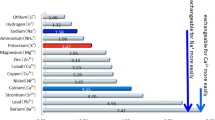Abstract
Objective
To describe the safety and efficacy of sodium polystyrene sulfonate (SPS) in pediatric patients with acute hyperkalemia.
Methods
A retrospective chart review of all patients less than 18 years of age administered SPS for acute hyperkalemia at Texas Children’s Hospital between 2011 and 2014.
Results
Our cohort consisted of 156 patients (mean age 6.8 ± 6.1 years). The peak mean potassium concentration observed was 6.5 ± 0.77 mmol/l prior to administration of SPS. The mean SPS dose was 0.64 ± 0.32 g/kg. The majority (91 %) of the SPS doses were given orally. The nadir mean potassium concentration in the 48 h post-SPS was 4.7 ± 1.2 mEq/l, which occurred at 16.7 ± 14.7 h post-dose. In the 48 h following SPS administration, 68 (43 %) patients required at least one additional intervention after SPS dose. Patients who required an additional intervention after initial SPS dose differed significantly in weight, baseline serum potassium, and were more likely to have received SPS treatment via the rectal route. A gastrointestinal adverse event was documented in 24 (15 %) patients.
Conclusions
SPS was used effectively and safely in the majority of patients in this report. However, it may not be appropriate as a first single-line agent in patients with severe acute hyperkalemia who require a greater than 25 % reduction in serum potassium levels or those at a high risk for cardiac arrhythmias.

Similar content being viewed by others
References
Evans BM, Jones NC, Milne MD, Yellowlees H (1953) Ion-exchange resins in the treatment of anuria. Lancet 265:791–795
Kamel KS, Schreiber M (2012) Asking the question again: are cation exchange resins effective for the treatment of hyperkalemia? Nephrol Dial Transplant 27:4294–4297
Bunchman TE, Wood EG, Schenck MH, Weaver KA, Klein BL, Lynch RE (1991) Pretreatment of formula with sodium polystyrene sulfonate to reduce dietary potassium intake. Pediatr Nephrol 5:29–32
Chlumska A, Boudova L, Pavlovsky M, Sulc M (2002) Intestinal necrosis following calcium resonium-sorbitol administration in a premature uraemic infant. Cesk Patol 38:169–172
Filippi L, Cecchi A, Dani C, Bertini G, Pezzati M, Rubaltelli FF (2004) Hypernatraemia induced by sodium polystyrene sulphonate (Kayexalate) in two extremely low birth weight newborns. Paediatr Anaesth 14:271–275
Malone TA (1991) Glucose and insulin versus cation-exchange resin for the treatment of hyperkalemia in very low birth weight infants. J Pediatr 118:121–123
Ohlsson A, Hosking M (1987) Complications following oral administration of exchange resins in extremely low-birth-weight infants. Eur J Pediatr 146:571–574
Rugolotto S, Gruber M, Solano PD, Chini L, Gobbo S, Pecori S (2007) Necrotizing enterocolitis in a 850 gram infant receiving sorbitol-free sodium polystyrene sulfonate (Kayexalate): clinical and histopathologic findings. J Perinatol 27:247–249
Sherman S, Friedman AP, Berdon WE, Haller JO (1981) Kayexalate: a new cause of neonatal bowel opacification. Radiology 138:63–64
Bellet S (1955) The electrocardiogram in electrolyte imbalance. AMA Arch Intern Med 96:618–638
Braun HA, Surawicz B, Bellet S (1955) T waves in hyperpotassemia; their differentiation from simulating T waves in other conditions. Am J Med Sci 230:147–156
Scherr L, Ogden DA, Mead AW, Spritz N, Rubin AL (1961) Management of hyperkalemia with a cation-exchange resin. N Engl J Med 264:115–119
Flinn RB, Merrill JP, Welzant WR (1961) Treatment of the oliguric patient with a new sodium-exchange resin and sorbitol; a preliminary report. N Engl J Med 264:111–115
Harel Z, Harel S, Shah PS, Wald R, Perl J, Bell CM (2013) Gastrointestinal adverse events with sodium polystyrene sulfonate (Kayexalate) use: a systematic review. Am J Med 126(264):e9–24
Hu PS, Su BH, Peng CT, Tsai CH (1999) Glucose and insulin infusion versus Kayexalate for the early treatment of non-oliguric hyperkalemia in very-low-birth-weight infants. Acta Paediatr Taiwan 40:314–318
Author information
Authors and Affiliations
Corresponding author
Ethics declarations
Conflict of interest
On behalf of the authors, the corresponding author states that there are no conflicts of interest to declare. There is no potential conflict of interest, real or perceived, in the preparation of this manuscript and no funding was received for preparation of this manuscript. Brady S. Moffett, PharmD, MPH wrote the first draft of the manuscript, and Ji Lee, PharmD has approved the final draft. The authors report no conflicts of interest including employment, consultancies, stock ownership, honoraria, paid expert testimony, patent applications/registrations, and grants or other funding.
Rights and permissions
About this article
Cite this article
Lee, J., Moffett, B.S. Treatment of pediatric hyperkalemia with sodium polystyrene sulfonate. Pediatr Nephrol 31, 2113–2117 (2016). https://doi.org/10.1007/s00467-016-3414-5
Received:
Revised:
Accepted:
Published:
Issue Date:
DOI: https://doi.org/10.1007/s00467-016-3414-5



